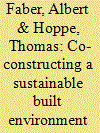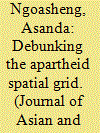|
|
|
Sort Order |
|
|
|
Items / Page
|
|
|
|
|
|
|
| Srl | Item |
| 1 |
ID:
117275


|
|
|
|
|
| Publication |
2013.
|
| Summary/Abstract |
There is considerable scope for energy efficiency improvements to the housing stock in the Netherlands. Although, economically, there are many technological opportunities available, the Dutch built environment has difficulty to harvest this potential. This paper applies a sectoral innovation system approach to investigate this apparent paradox. This approach allows to identify and assess systemic barriers that prevent improvement in overall energy efficiency of the Dutch housing sector. Twenty-one experts were interviewed, and a qualitative data analysis was applied to identify barriers, and relate them to key dimensions in the sectoral innovation system framework. From this analysis, we identified poor regulatory design, lack of market demand, and some institutional characteristics of the construction sector as the key systemic barriers that hamper the diffusion of green energy innovations in the Dutch housing sector.
|
|
|
|
|
|
|
|
|
|
|
|
|
|
|
|
| 2 |
ID:
178253


|
|
|
|
|
| Summary/Abstract |
Traditional universities are often interrogated on their pedagogic underpinnings, while universities of technology are often left unchallenged on knowledge production. Universities of technology are often assumed to be transformed because they are a post-apartheid creation, with a mainly black, working-class student body. This assumption has led to little interrogation of the university of technology and its relationship with knowledge production. This paper explores the nature of curriculum contestation and reform at a university of technology. It outlines the historical context of a university of technology and its approach to curriculum development, which has implications for current curriculum transformation efforts. Using autoethnographic research methodology, the paper tracks a multi-year journey towards the development of a transformative, socially just curriculum intervention in the extended curriculum programme for the Architecture and Interior Design programme at a university of technology. The paper concludes that curriculum change does not happen in a vacuum, that it is political, difficult and emotionally taxing, and that it is best done in collaboration with different education stakeholders.
|
|
|
|
|
|
|
|
|
|
|
|
|
|
|
|
| 3 |
ID:
191295


|
|
|
|
|
| Summary/Abstract |
Energy Performance Certificates (EPCs) are designed to provide consistent and comparable energy efficiency ratings. Since 2008, any building constructed, rented or sold is required to obtain an EPC in the UK. 4% of simple office buildings have renewed their EPC to date in England and Wales. In this paper, by comparing the original and renewed EPCs of these buildings, we examine the reliability of non-domestic EPC ratings and discover realistic energy efficiency improvement strategies reflected in the changes. We have found that buildings with their conditions remaining unchanged can be better rated by approximately 10 points on average when their initial rating is above the minimum requirement in the regulation. The ones initially rated below the minimum requirement are expected to have a greater scale of improvement on ratings while making no efforts which brings doubts on the effect of the “Minimum Energy Efficiency Standard” policy. Evidenced human factors are also jeopardising the fairness of EPC ratings. Based on the changes in the EPCs, we have found 4 clusters of improved buildings and 5 clusters of deteriorated buildings. We derived practical energy efficiency improvement strategies that people have already naturally adopted.
|
|
|
|
|
|
|
|
|
|
|
|
|
|
|
|
| 4 |
ID:
150719


|
|
|
|
|
| Summary/Abstract |
The likely installation of, and potential energy savings from, low carbon technologies in domestic buildings is not only dependent on those who fit them, but also the broader supply chains of which they are part. Despite this, the role of supply chain actors has been largely overlooked in strategies seeking to encourage the installation of more sustainable domestic heating technologies. With reference to central heating, this paper responds through an ethnographic analysis of how plumbers' merchants and sales representatives can influence the work of heating installers in the United Kingdom. It applies two dimensions of the concept of ‘social capital’: relational and structural. Relational social capital focuses on the trust, loyalty and reciprocity at play in relations, whilst structural social capital considers how the strength of tie can influence those to whom people turn for advice and support. Together, these ideas demonstrate how relationships amongst these groups can serve to influence product choice and facilitate information exchange. The paper concludes by discussing how these supply chains might be engaged with as a means of encouraging the installation of low carbon domestic technologies.
|
|
|
|
|
|
|
|
|
|
|
|
|
|
|
|
| 5 |
ID:
133119


|
|
|
|
|
| Publication |
2014,
|
| Summary/Abstract |
The built environment can be used to influence travel demand, but very few studies consider the relative energy savings of such policies in context of a complex urban system. This analysis quantifies the day-to-day and embodied energy consumption of four different neighborhoods in Austin, Texas, to examine how built environment variations influence various sources of urban energy consumption. A microsimulation combines models for petroleum use (from driving) and residential and commercial power and natural gas use with rigorously measured building stock and infrastructure materials quantities (to arrive at embodied energy). Results indicate that the more suburban neighborhoods, with mostly detached single-family homes, consume up to 320% more embodied energy, 150% more operational energy, and about 160% more total life-cycle energy (per capita) than a densely developed neighborhood with mostly low-rise-apartments and duplexes. Across all neighborhoods, operational energy use comprised 83 to 92% of total energy use, and transportation sources (including personal vehicles and transit, plus street, parking structure, and sidewalk infrastructure) made up 44 to 47% of the life-cycle energy demands tallied. Energy elasticity calculations across the neighborhoods suggest that increased population density and reduced residential unit size offer greatest life-cycle energy savings per capita, by reducing both operational demands from driving and home energy use, and from less embodied energy from construction. These results provide measurable metrics for comparing different neighborhood styles and develop a framework to anticipate energy-savings from changes in the built environment versus household energy efficiency.
|
|
|
|
|
|
|
|
|
|
|
|
|
|
|
|
| 6 |
ID:
125518


|
|
|
|
|
| Publication |
2013.
|
| Summary/Abstract |
Energy efficiency is considered one of the most cost effective ways to enhance security of energy supply and reduce greenhouse gas emissions. According to Europe's Energy Efficiency Plan, the biggest energy savings potential in the EU lies in the built environment. However, the many barriers to energy efficiency have prevented the implementation of the existing potential so far. This paper evaluates the existing policy instruments aimed at energy efficiency in buildings in Spain as laid down in the 2nd National Energy Efficiency Action Plan (NEEAP). The results show that the current policy package is insufficient to yield the existing energy savings potential in this sector. As much of the savings potential can be found in existing buildings and realization of this potential very much relies on voluntary action, the renovation sector is in need of an appropriate financial framework that mobilizes sufficient public and private financial resources, and transparent and efficient mechanisms to ensure the return on investment and payments from those who benefit from the renovation. Such financial framework needs to be supported by a regulatory framework that is tuned to existing buildings and an organizational framework that effectively connects the different policy layers in Spain.
|
|
|
|
|
|
|
|
|
|
|
|
|
|
|
|
| 7 |
ID:
150908


|
|
|
|
|
| Summary/Abstract |
The Dutch Government stimulates the application of energy efficiency measures to reduce the energy requirements of buildings, which are responsible for about 20% of the Dutch CO2 emissions. For our assessment, we followed a qualitative approach, due to a lack of data. We reviewed the mix of policy instruments and used stakeholder surveys and interviews. We found that energy use is not very likely to decline fast enough to achieve the Dutch policy targets for 2020. For new buildings, the policy mix works well, but its contribution to the policy targets is limited. For non-residential buildings the current Act, which obliges enterprises to take cost-effective measures, could be enforced to a greater degree. For privately owned homes a more compelling policy is needed. An alternative policy option would be to make taxation dependent on the energy label of residential houses. This would stimulate residents to take action while retaining the desired autonomy. For rental housing, binding agreements between municipalities and housing corporations may lead to more energy saving measures. Finally, we conclude that the Dutch energy tax is an important pillar of the current policy. It provides higher cost-effectiveness of energy saving measures and legitimates more strict energy efficiency standards.
|
|
|
|
|
|
|
|
|
|
|
|
|
|
|
|
| 8 |
ID:
122936


|
|
|
|
|
| Publication |
2013.
|
| Summary/Abstract |
A major goal of the national program to Build a New Socialist Countryside is to modernise and urbanise the rural built environment. This objective has been bolstered by the extension of state-sponsored urban planning regimes into rural jurisdictions. One of the implications of this is that every administrative village in China is now required to commission and implement a 20-year "master plan" for redevelopment. Through tracing the origins and rationale of key policy initiatives, in the first part of this paper I aim to show how urban planning came to be seen as an appropriate tool for solving a range of intractable rural "problems." In the second part of the paper, I present a case study of village redevelopment in order to illustrate how the principles of urban planning have been applied to the re-making of rural built environments and the transformation of rural life.
|
|
|
|
|
|
|
|
|
|
|
|
|
|
|
|
|
|
|
|
|